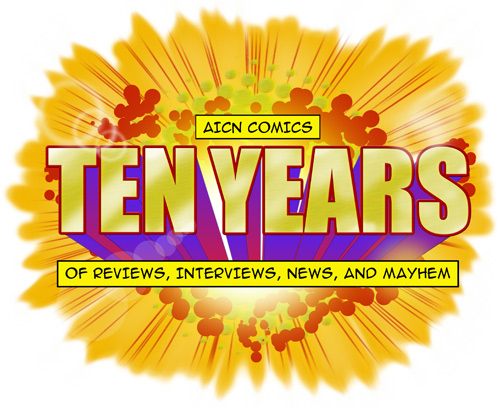
| Issue #43 | Release Date: 1/11/12 | Vol.#10 |
(Click title to go directly to the review)
Advance Review: DEAD MAN’S RUN #1
WOLVERINE #300
WHISPERS #1
A TOWN CALLED SUCKHOLE Novel
THE SHADE #4
REED GUNTHER #7
BUFFY THE VAMPIRE SLAYER SEASON 9 #5
FRANKENSTEIN: AGENT OF S.H.A.D.E. #5
ONE MODEL NATION OGN
X-FACTOR #230
CHEAP SHOTS!
AICN COMICS PODCAST #12
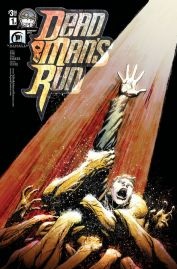 Advance Review: In stores this week!
Advance Review: In stores this week!DEAD MAN’S RUN #1
Writer: Greg PakArtist: Tony Parker
Publisher: Aspen Comics
Reviewer: Lyzard
I got a look at DEAD MAN’S RUN last year. It just wasn’t my cup of tea. When I got the opportunity to review DEAD MAN’S RUN #1, I decided to give it another chance. I looked through it quickly before deciding to go ahead because after a quick skim it looked more like a comic I’d enjoy.
Conceptually I do like DEAD MAN’S RUN. The idea of what hell may be truly like has always been an area of curiosity for me (doesn’t help that I’m Catholic). Tales like Dante’s INFERNO, even the constant threat and few depictions of Hell in SUPERNATURAL, always sparked my interest. I enjoy seeing the variations of what Hell is like to different people and who they believe deserves to spend eternity in its fires.
DEAD MAN’S RUN depicts Hell like a prison. Everyone there has sinned, though the degree of wrongful choices one makes to deserve a spot in Hell is never made clear. The characters we find in the complex, for the most part, appear to be the scum of the Earth, the “most dangerous criminals the world has ever seen.” In Greg Pak’s Hell, the occupants are just as scary as the demons.
What I didn’t get when I read the Issue #0, and continuing to Issue #1, was what is the point? There didn’t seem to be a big picture. In Issue #0 Captain Frank Romero is trying to hold off escaping prisoners from the Andrew Jackson Federal Corrections Facility in Los Olivados, California. There is much red tape that the captain has to deal with, creating difficulties in dealing with the prison riot. Why the captain requires a cartographer along with the hierarchy of the system is never fully explained.
Come Issue #1, the focus switches from the captain to the cartographer. Both Samuel Tinker and Juniper are killed, landing the cartographer in Hell. How is never explained, though the why is. The captain wants to use the cartographer’s knowledge of the structure to free himself.
Clearly both issues have a story, but it’s the risk I don’t get. Obviously the first issue’s risk is the well-being of those still on the surface. However, in the next issue, it becomes about saving the captain. However, should we care about this? Apparently he has sinned, otherwise why would he be in Hell? He talks of killing those who didn’t deserve it in a past war and also dies due to his greed, falling from temptation. The story doesn’t contain risk for other characters we have been introduced to. Even if it did, we haven’t been shown why we should care for them. The cartographer seems innocent enough, but his naivete is not enough for us to put our whole hearts into rooting for him.
The artwork I did dig. I saw Parker’s work in DO ANDROIDS DREAM OF ELECTRIC SHEEP when I was writing a paper on the Phillip K. Dick book. His drawings help create the uniqueness of Pak and his idea of Hell. I’ve also got to give credit to David Curiel’s coloring. His touches truly do make a difference with his use of red, yellow, and blue to exemplify a specific tone and mood throughout the comic. However, I must say that Parker’s constant reliability on the outward grasp of the arm, especially the use of it with Tinker, did get redundant. I’m sure that there is another position, a different body language, which could denote the same feelings he has.
Overall, I see DEAD MAN’S RUN as a series with a strong concept and interesting artwork, but it has yet to have a clear storyline. It needs to define its purpose, and make clear what this story is about.
Lyzard is actually Lyz Reblin, a senior screenwriting major with an English minor at Chapman University. Along with writing for AICN, she has been published twice on the subject of vampire films.
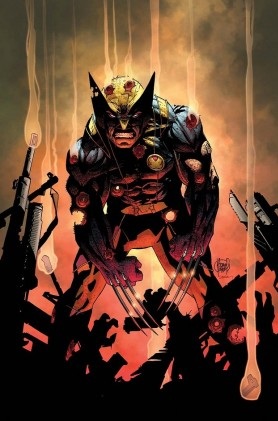
WOLVERINE #300
Writer: Jason AaronArt: Adam Kubert
Publisher: Marvel Comics
Reviewer: The Dean
I’m not super sure why I bought the blank variant cover for WOLVERINE #300, but I did, and I’m living with it. However, other than Marvel asking me to pay $4.99 for a cover someone forgot to draw on (and me actually paying for it), I found very little to dislike about this milestone issue. You know, it’s funny; we all knew this day would come, but it’s still so hard to believe, isn’t it? They’ve really done it, though. The folks at Marvel have actually squeezed Wolverine into 300 titles in just over a month…a truly remarkable achievement. All kidding aside, there a lot of options out there to get your Wolverine fix, but with WOLVERINE #300, Jason Aaron’s given us reason to believe that the character’s self-titled series may once again be the best one out there.b
There’s a lot of tablesetting going on in this issue, and our clawed Canucklehead is left relatively speechless through most of it. But the occasional scraps here and there where we do see Wolverine being Wolverine serve the story well, by both sating our hunger for diced ninja and even acting as an interesting scene transition near the issue’s end. I love the underworld warfare storyline we’re getting, and am very excited to see the characterization of the Silver Samurai’s replacement develop as well. In all honesty, Wolverine was probably the least interesting character in this issue, with the development of the supporting cast really stealing the show. If there is a complaint here, it could be that there’s too much going on for one issue, but as it’s very well-paced, it never feels weighted down or too ambitious. This is definitely looking to be a worthwhile trip back to Japan for Wolverine, which could even wind up being comparable to his first – a pleasant surprise from the “You guys remember Chris Claremont?” cash grab I was half-expecting (the other half knew better than to doubt Jason Aaron ).
As for the art, Chapters 1,4, and 7 of this issue are Adam Kubert, and the rest are not. Kubert draws my favorite Wolverine, admittedly for mostly nostalgic reasons, and he’s bringing everything he’s got to this one. The other teams on show here, Ron Garney & Jason Keith, and Steve Sanders & SotoColors, do a commendable job, and there’s nothing of note to complain about here. But Kubert & Paul Mount’s sketchy, aggressive look fits Wolverine so well in my opinion that any other art shown alongside theirs seems out of place.
As well as the art and storytelling pair here, they provide an enjoyable a contrast to Aaron’s other series, WOLVERINE AND THE X-MEN. While both are great reads separately, you get this awesome Indiana Jones take on Wolverine when the two are read together. The more lighthearted adventuring of headmaster Logan at the Jean Grey school helps to breathe new life and a rekindled interest into the Weapon X killing machine we all know and love. If you’ve been passing on WOLVERINE previously for whatever reason (maybe you’ve been holding off, waiting for his inevitable appearance in your Halo comics), this is a perfect jumping on point for you. It feels like a lot of Aaron’s previous work has built naturally to this arc, and this could very well wind up being his best work on the title to date.
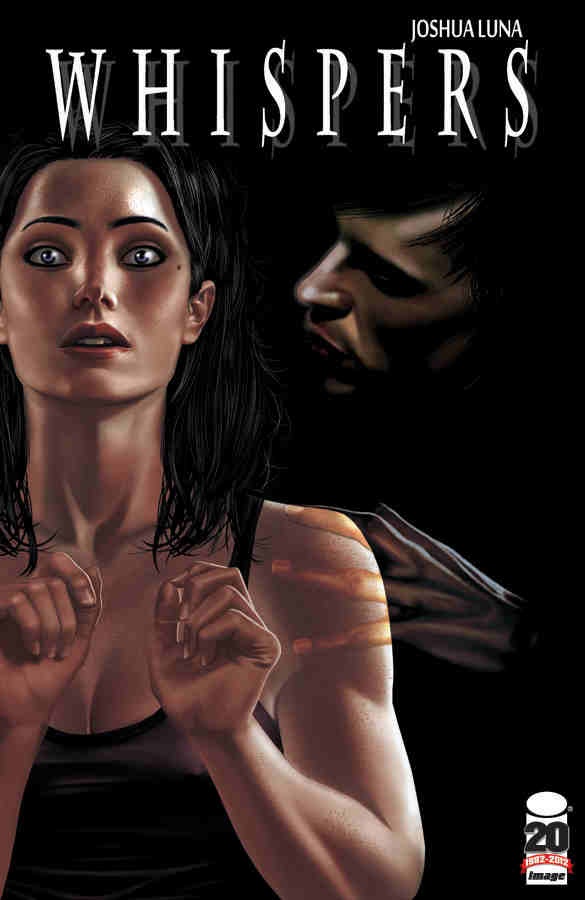
WHISPERS #1
Writer: Joshua LunaArt: Joshua Luna
Publisher: Image Comics
Reviewer: The Writing Rambler
Every once in a blue I decide to tread out of my comfort zone where superheroes & mainstream stories about multicolored lanterns help lull me into a nice warm happy place and instead pick up something that looks and feels a little different than what I’m used to. I recently did just this with one of Image’s newest releases, WHISPERS #1, and I couldn’t be happier that I did. WHISPERS manages to suck the reader in with this first issue and tell an extremely well-written narrative about a man struggling just to make it through his everyday routines who discovers powers beyond his wildest dreams.
Joshua Luna (of the Luna brothers) ventures out for his first solo project with WHISPERS and shows that he can clearly handle both writing and artist duties. The story introduces us to Sam Webber, a man struggling with severe OCD who has just come to realize he is able to access the minds of others in his dreams. The protagonist is likeable from the first page and by the end of the issue Luna has you completely invested in where Sam’s next choice will take him. There’s a beauty to this story and Sam’s character as a whole that makes this a joy to read. You can smile at his over the top OCD issues while completely sympathizing with the crippling condition he suffers from. Even his newfound “abilities” come with limits that make them feel believable despite the entire supernatural element of the story. While some of the side characters felt a little flat, it in no way diminished the story as this first issue is clearly all about getting us invested in Sam Webber and Luna does that near perfectly.
Luna’s artwork in the issue is a perfect parallel to the story as its simple and clean style paints the picture of Sam’s struggles and experiences with his new “power”. You can see the pain in Sam’s face as he attempts to share what he’s been experiencing to a group of friends who are dealing with their own personal issues. There’s real character depth and story told visually in each panel as Sam further explores what he can do with these abilities. It’s simple, yet beautiful, and a great start to what I’m sure will be a very interesting new series.
I can’t wait to see where Luna goes with this story and how he chooses to explore the morality choices presented in this first issue for Sam as he starts to realize just how he can enter into the minds of some and the influence he may have over them in the future. The power he is unlocking matched against his own personal struggles is great balance for this type of story. Luna has created an excellent protagonist in Sam Webber and if this first issue is an indicator of the type of story we can expect in future installments I’d say Luna has a very successful first solo project on his hands.
You can follow The Writing Rambler on his blog here and follow on Twitter @Writing_Rambler !
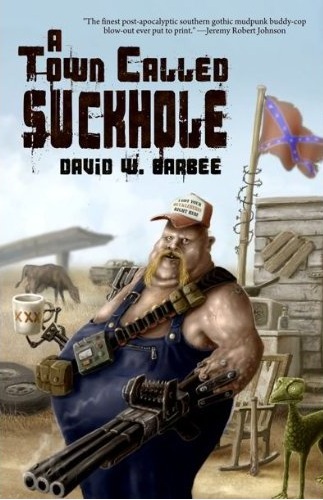
A TOWN CALLED SUCKHOLE Novel
Writer: David W. BarbeeIllustrator: Hauke Vagt (Cover)
Publisher: Eraserhead Press
Reviewer: Mr. Pasty
I wasn’t quite sure what to make of my shiny new copy of A TOWN CALLED SUCKHOLE when it first hit my doorstep, courtesy of author David W. Barbee. I say that because his story takes place in the new-old South, if that makes any kind of sense. Try to imagine Akira’s Neo-Tokyo, only instead of clowns on motorcycles we have hillbillies in El Caminos. I didn’t have the heart to tell Barbee I was Yankee scum (ha ha ha sucker! We won!), or that I was the direct descendant of a Union lieutenant, but hey, how bad could a story be that starts out with the hicks from down south trying to rise up from a nuclear wasteland? That means they’ve had a few bombs dropped on them at some point in his imagined universe and well, that’s what we northerners like to call a happy ending. Not as happy as the one I get from that Asian chick at Fanny Lu’s massage parlor on the corner of Fifth and Washington, but you get the idea.
SUCKHOLE brings you a post-apocalyptic Dixie, a town of slack-jawed rednecks with a killer on the loose. Their only hope of solving the case and bringing the murderer to justice is a half-wit Sheriff and a swamp creature named Dexter, who is not exactly high on the list of town favorites. To call SUCKHOLE an original work of fiction would be a bit misleading, because at its core, it’s not anything we haven’t seen before. The good news is, I don’t think we’ve ever seen it done quite like this. That works in Barbee’s favor because the familiarity of his story (murder mystery, exiled loner, mysterious woman) allow the reader to find a shallow sandbar in which to secure their footing in what can only be described as an ocean of zany characters that will challenge your imagination and teeter on the line of absurdity -- without going over. That’s an impressive balancing act because every world requires rules and being creative for the sake of creativity is usually a colossal failure. Not this time.
The key to Barbee’s success is his character development, and I would even go as far as to say the town itself is a character, beautifully realized through unconventional means. I mean, let’s face it: this is not a happy place. Barbee’s SUCKHOLE is like one big birth defect, yet somehow he makes it all appealing. The dialogue is smothered and covered like an order of Aussie fries at the neighborhood Outback, and the gooier it gets, the more delicious it is to digest. The highest compliment I can give A TOWN CALLED SUCKHOLE is that it felt like I was transported into a live action version of REDNECK RAMPAGE. That goes down as one of the greatest video games I ever played because of the yee-haw atmosphere and exaggerated stereotypes of southern living. I never thought I could find a way to replicate the fun I had playing it until I read SUCKHOLE. It’s a novel that reads like a comic, only much longer and much more gratifying. Highly recommended.
Web heads who can’t get enough of Mr. Pasty’s word vomit are encouraged to watch him operate as Nostradumbass over at MMaMania.com here. Love, hate and Mafia Wars requests should be directed here.
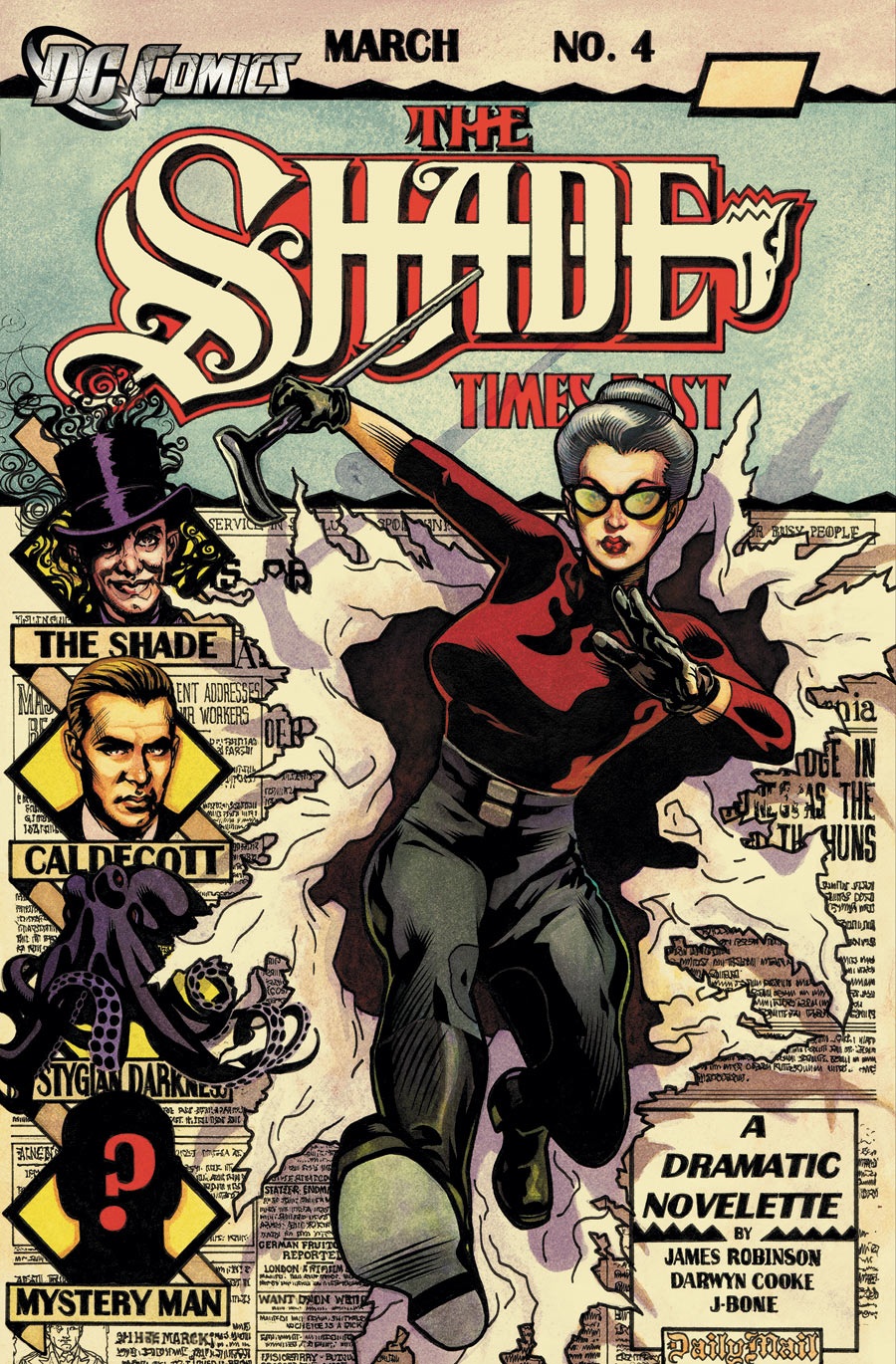
THE SHADE #4
Writer: James RobinsonPenciler: Darwyn Cooke
Published by: DC Comics
Reviewed by: BottleImp
See, THIS is where James Robinson makes sense.
Not in charge of the Man of Steel. Not directing the cluster of B-Listers that was his run on JUSTICE LEAGUE OF AMERICA. Here: The Shade, Opal City, and above all else, Robinson’s obvious love of DC’s history. This appreciation for the colorful characters that populated the comic pages back in the 1940s and ‘50s adds an indefinable quality to Robinson’s writing that turns a good story into a great one.
For instance, this issue of THE SHADE is a reminiscence of times past by our rakish, somewhat heroic anti-hero. The year is 1944, and wartime patriotism finds its way even into the shadowy heart of the sometime villain. The plot is almost textbook spy thriller, with the Shade seeking to find kidnapped industrialist Darnell Caldecott, whose aid in the war effort against the Axis has earned him the enmity of the Nazi forces. Caldecott just also happens to be the ever-youthful Shade’s great-grandson, but that’s a detail that matters more in the larger scope of the series and has little bearing on this issue’s plot. Fifth Columnists are fought, a traitor is revealed, and a daring air rescue is mounted…but like I said, that’s all pretty by-the-book for a story of this type. No, what elevates this issue to a level greater than the knotted plot threads is that genuine love of DC’s classic characters.
First, there’s the obligatory team-up, as the Shade needs assistance to loosen tongues as to Caldecott’s whereabouts. Robinson chooses to bring in the Vigilante for this role, a fringe character if there ever was one (although the motorcycle-riding cowboy has certainly gotten more broad exposure in recent years, thanks to his inclusion in several episodes of the excellent “Justice League Unlimited” animated series), and a character that Robinson obviously has no small amount of fondness for, having penned a Vigilante miniseries back in the mid-‘90s. The inclusion of this second-stringer alone brings a smile to the face of any reader who has a glimmering of DC’s history, but that’s nothing—NOTHING—compared to the other, long-neglected character Robinson features in this issue, a character whose inclusion brought an ear-to-ear grin to the face of this Golden Age fan.
Two words: Madame Fatal.
If you’re simply scratching your head at the name, I urge you to first read this issue, then go to the trusty Wikipedia to learn more about this most unconventional superhero. She was one of the heroes that DC acquired along with the Ray, Plastic Man and other characters published by Quality Comics back during the World War II era, yet Madame Fatal was never used by her new publisher for anything but a passing (and usually disparaging) reference…until now. James Robinson, the man who was able to bring the stories of the Golden Age to new generations of readers, has done the nigh-impossible. He has made Madame Fatal awesome. And that alone is reason enough to pick up this comic.
And hey, if it’s visual stimulation you crave, you STILL should pick up this comic. The art has a wonderfully retro feel that goes a long way towards evoking the time-period of the mid-‘40s, combined with a dynamic energy in its composition that makes the cartoony figures fairly bristle with energy. The drawings are by some guy named…let me see…Darren somebody? Someone Cook? I think he did some work for DC a few years back called THE FINAL FRONTIER, or something like that. Whoever he is, this newcomer shows a lot of promise—be on the lookout for more from him in the future.
What’s that?
THE NEW FRONTIER? Won all sorts of awards? One of the top writer/artists of our time?
Oh. Well, I did say I was a fan of the Golden Age; I don’t have time to keep up with all that newfangled stuff the kids are reading.
When released from his bottle, the Imp transforms into Stephen Andrade, an artist/illustrator/pirate monkey painter from New England. He's currently hard at work interpreting fellow @$$Hole Optimous Douche's brainwaves and transforming them into pretty pictures on AVERAGE JOE, an original graphic novel to be published by Com.x. You can see some of his artwork here.
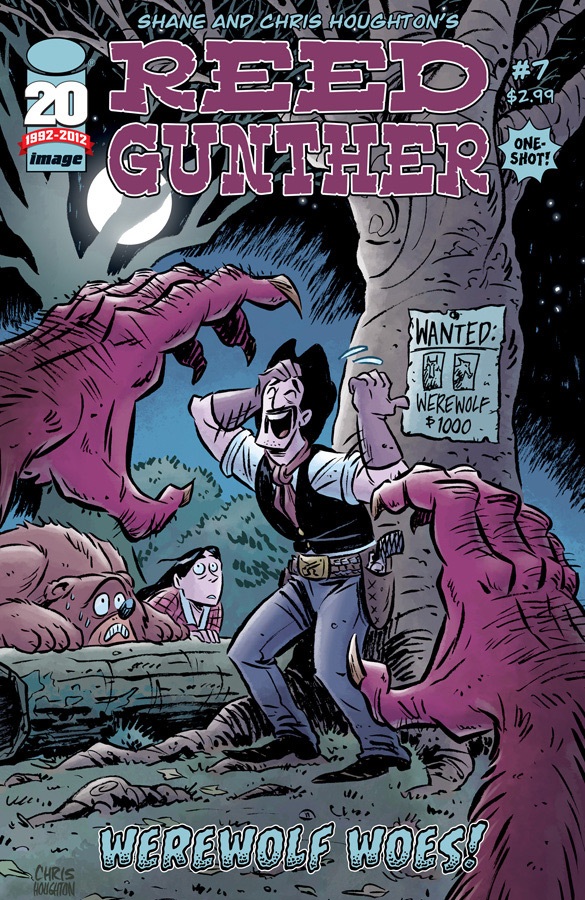
REED GUNTHER #7
Writer: Shane HoughtonArtist: Chris Houghton
Publisher: Image Comics
Reviewer: Lyzard
I have never been a fan of most Westerns. Maybe that makes me unpatriotic, seeing as the genre is essentially as American as baseball and apple pie, but I have just never been a fan. My friends have always found that a bit odd, being as I grew up in Houston, Texas. I would go to the rodeo every year, clogging my arteries with deep fried Twinkies and watching masochists get back massages from bulls in the Astrodome. You would think that Westerns would be right up my alley.
That is where REED GUNTHER comes into play. I reviewed the first issue for another site and fell in love with it. In many ways, REED GUNTHER is what I desire from a Western: faster pacing, over-the-top antics, and humor. I’ll take a RANGO, MAVERICK, or BLAZING SADDLES any day over a Clint Eastwood spaghetti western or a John Wayne/John Ford flick.
In REED GUNTHER WEREWOLF WOES! our hero, along with his trusty bear Sterling and companion (only in the travelling sense) Starla, is in need of some cash. So when an eye-patched woman comes to town looking for a monster slayer, Reed is rarin’ to go. That is, until he finds out what sort of hairy situation he has gotten himself, and his friends, into.
REED GUNTHER may appear childish on the surface. It doesn’t have the satirical or parodic qualities of works like SHREK, where there are clearly jokes that go over the heads of the younger readers. REED GUNTHER is wholesome, but unlike the numerous Archie publications I have had to read, wholesome doesn’t equal boring for this Image comic. Shane Houghton’s writing proves to be humorous without having to be crass. Some may accuse him of watering down the genre, but I argue that he is streamlining it. Shane clearly knows his Westerns, exemplified by his characters that include the mob-like townsfolk who run straight after a monster in the beginning of the comic, then proceeding to the bonnet-wearing yet tough as nails woman whose town is being destroyed by a werewolf.
REED GUNTHER is a comic that could have pulled off the COWBOYS VS. ALIENS story way better than the movie, because it would have been believable in the world created by the Houghtons. Aliens, monsters, it makes no difference. The Houghtons have captured the fabled and legendary aspect of the Old West, where tales of gunslingers and cowboys overcoming impossible odds had more hyperbole than their kernel of truth.
For this reason, the artwork of REED GUNTHER need not be realistic. Chris Houghton’s drawings are cartoonish, but those again play back into the tall tale aspect of the series. Characters that are meant to be laughed at are drawn to be more ridiculous than those characters that actually get the work done, so Starla, who is the real brains of the trio, would never end up in the Rube Goldberg situations of Reed.
It still surprises me that the company that publishes THE DARKNESS, HACK/SLASH, CHEW, and numerous other dark comics would also be the same press that brings us this. But only in REED GUNTHER’s tameness is it different than its Image companions. In quality, it can stand tall with the best of them.
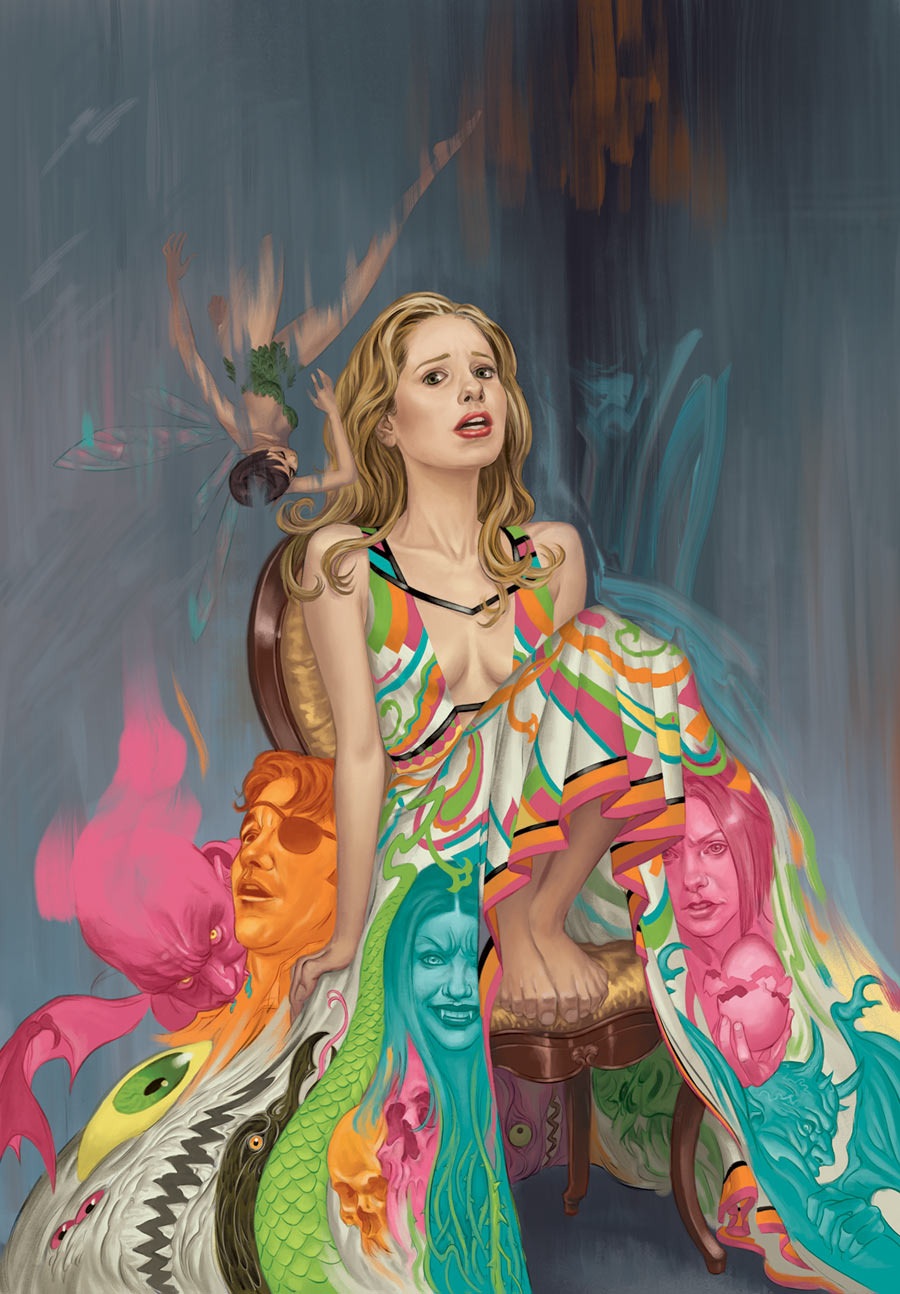
BUFFY THE VAMPIRE SLAYER SEASON 9 #5
Writer: Andrew ChamblissArtist: Karl Moline (Pencils) Andy Owens (inks)
Publisher: Dark Horse Comics
Reviewer: Henry Higgins is My Homeboy
Adult Problems…
I love BUFFY THE VAMPIRE SLAYER; I found it in high school, and while my passion for the series has been cooled slightly by age, it's still one of the television series that I'll occasionally do a run of. After the bombastic opening to the new Buffy run, Chambliss and Moline take a step back and take time to look at the new status quo. And while it's well done, it brings natural comparisons to things such as "Restless", which are still slightly stronger.
Writing: (3/5) This issue reads as the new status quo, setting up numerous storylines to follow up on. To communicate these beats, Chambliss takes the typical Buffy route of the dream state. And there in lies the problem: for a universe that utilized the prophetic dream so well in the past, I found this one lacking. The dream is a little obvious, and its message is clear from the onset if you're paying attention. It's an unusually inconsistent dream, and it's slightly dull. While featuring the return of a character from earlier in the series is a nice touch, the dream itself is never that impressive. It does hint at the disappearance of Willow, which could go either way in terms of interest, but it leaves too much open.
Something that has to be said for Chambliss, though, is he knows how to write these characters; Buffy and Willow sounds perfect, and they're featured primarily through the issue. The two have their familiar banter down, and rarely has the conversation in these stories sounded so like the original show. The scenes with them just talking reads brilliantly.
Art: (4/5) This series has always had good art, and Moline is definitely a good choice for the run. The opening scene, which features a barrage of vampires advancing on Buffy, Xander, and Dawn, is utterly fantastic looking. It moves well, and flows just as an action scene should. The quieter scenes between Buffy and Willow are well done as well, resembling their original actresses while remaining colourful and unique. If there're any problems, it's some of the inconsistencies that stand out. Sometimes, the faces just seem weird and out of place. But for the most part, it's a solid issue, art wise.
Best Moment: The opening fight scene.
Worst Moment: The dream leaves the reader disappointed.
Overall: (3/5) A solid issue, if disappointing just because one sees "Buffy vision time" and expects more.
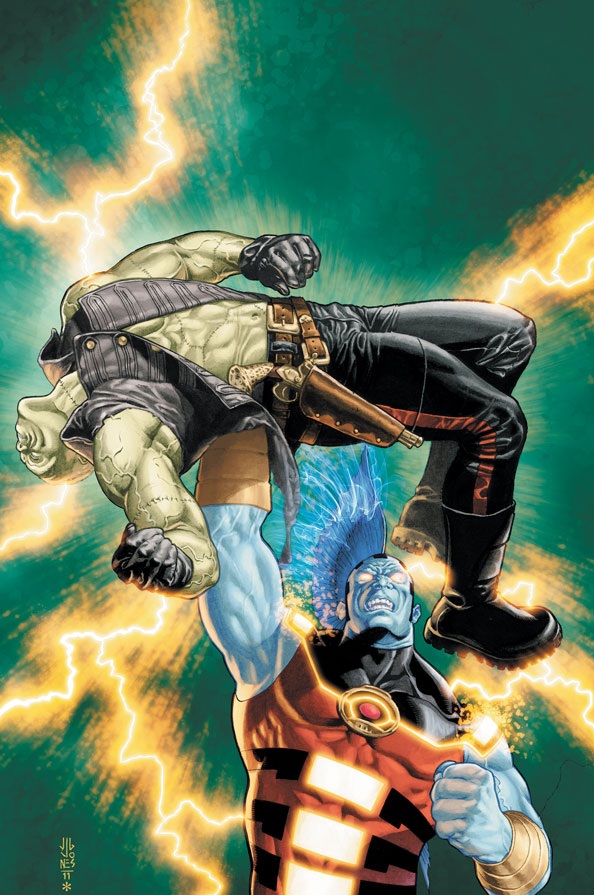
FRANKENSTEIN AGENT OF S.H.A.D.E #5
Writer: Jeff LemireArtist: Alberto Ponticelli
Publisher: DC Comics
Reviewer: Optimous Douche
It was with great fear and a trembling clicker finger I clicked open the email from the DC Public Relations department last week announcing the first set of books being wiped from the New 52. While I’ve been enjoying books like ACTION and BATMAN, I’ve been finding the true originality and something different within the titles that play “just the tip” within the DC Universe like JUSTICE LEAGUE DARK, DEMON NIGHTS, ANIMAL MAN and of course FRANKENSTEIN. I also know I’m a rarity. Sales figures show that not everyone likes living in such a wide orbit from the warm epicenter of DC’s main staples.
Fortunately none of my favorites were cancelled, and that includes the wonderful weirdness of FRANKENSTEIN. However, Frank’s chief foil in this one-shot adventure, OMAC, may escape the divine retribution of Frank’s sword, but no character can escape the final fate of poor sales figures.
I tried to like OMAC, I really did. It is loved by many comic reviewers and industry insiders whose opinions I hold dear and with the utmost respect. I also get why they like it; Didio and his co-writer captured the essence of the Silver Age and paid homage to the Kirby style on every page. I simply don’t like the Silver Age. I appreciate the evolutionary jump it provided to get us where we are today, but I’m simply not one for resting on laurels or spending too much time in yesteryear.
No, this is not the SEVEN SOLDIERS FRANKENSTEIN, but I would like us all to engage in a group catharsis by repeating, “Grant Morrison can’t write every book in the DC universe.” And I whole heartedly believe he shouldn’t. Morrison’s true gift is deconstruction--atomizing a character to its core elements and then reconstructing into a finite but grandiose new arc. But you have to build before you can deconstruct. Plus finite is not what comics are about. I wanted to get this gripe out of the way now, though I foolishly know there will be at least one TalkBack post that makes this ludicrous comparison.
This is a new FRANKENSTEIN with a cadre of creature commandos to help him on his way. The thing I love most about this series is Jeff Lemire. Lemire has the unique ability to imbibe the fantastical, but ensures that each character he creates carries equal parts humanity and emotion. FRANKENSTEIN was another character that did not undergo a complete reset in the New 52. He entered the series with a wife (excuse me, ex-wife), the juxtaposition of a beautiful soul to counterbalance his outwardly monstrous appearance and a sense of justice that is almost divine in nature with an undiluted potency of protecting those that can’t protect themselves. I don’t know about you, but I can’t think of any better recipe for a tormented anti-hero.
This series had me at issue one with its fantastical sci-fi trappings as well. The Headquarters for S.H.A.D.E is a vast city shrunken down to less than an inch in circumference thanks to the shrinking talents of contractor Ray Palmer. The group is run by Father Time, an immortal who keeps transplanting his brain into new bodies, the current incarnation of which is an eight year old girl. And then there are the Creature Commandos: a werewolf, a vampire bat, the aforementioned Mrs. Frankenstein and a lovely gilled scientist who seems to have taken a fancy to team leader FRANKENSTEIN.
In the series’ first arc this ragtag team takes a trans-dimensional shift to a planet that is being infected by a parasite that is looking to move this otherworld on top of Earth so they can take it over. Lemire is not usually known for action, but he broke into new territory to give this arc as much punch as feeling. Issue five is more of a respite and launch pad for the next arc and future issues, but I will say it’s the perfect issue to give FRANKENSTEIN a spin if you haven’t tried him out yet. While the issue is void of the Creature Commandos, FRANKENSTEIN is front and center as he goes after the escaped threat of OMAC.
As I said earlier, I don’t read OMAC, so when I was prompted with an editorial bubble on page one telling me if I wanted to see more of this story I would have to read OMAC #5 first I was worried. Would the dreaded crossover leave me feeling lost in a book I had been so religiously dedicated to reading each month since launch? Thankfully, no. OMAC fans take note: this is not a book that deepens the character of OMAC. Quite honestly, OMAC could have easily been replaced with “insert Generic Monster here.”
Apparently Brother Eye, the fated all knowing satellite we remember from the pre-52 universe, wants to infiltrate S.H.A.D.E’s network to learn how they build all of these wonderful toys. OMAC is basically bait to draw FRANKENSTEIN into close enough proximity so Brother Eye can hack into Frank’s headnet. Any network access point in a storm, as the saying goes. Apparently Checkmate, the clandestine UN-governed intelligence agency, has been in pursuit of OMAC over in his book, so they are the ones responsible for bringing in S.H.A.D.E to help thwart Brother Eye’s plans.
While it was very nice to see the addition of Checkmate and the return of Maxwell Lord as a good guy, it was all really unnecessary. The true crux of this book is to once again establish the tenets of FRANKENSTEIN’S persona and unravel new character threads that will carry the book into the next arc. Things we can expect in future issues will be a seek and explore on where Frank’s different body parts came from (i.e. the original owners) and this deepening relationship with the aforementioned doctor from the Black Lagoon.
I truly applaud DC for this issue; this is how a crossover really should be handled. I’ll be honest, I might have jumped into OMAC once I learned Checkmate was part of its lore if I hadn’t read this issue minutes after learning of OMAC’s demise. There was enough character development to keep OMAC fans happy without hampering the joy for those of us that went into the issue just wanting to see Frank.
I know Ponticelli’s propensity for eschewing reality into the ugly has put some fans off, but I think it’s the perfect tonality for this book. While I wish some panels were a little tighter and clearer, there is no denying that FRANKENSTEIN is an ugly character on the surface and it’s a big ugly universe.
For people that like their comics to be eclectic, imbibing the weirder side of Morrison with more cohesion and standard story throughput, FRANKENSTEIN is a book you should be reading.
Optimous has successfully blackmailed fellow @$$Hole BottleImp into being his artist on Average Joe. Look for Imp's forced labor on Optimous brain child in mid-2012 from COM.X. Friend Optimous on FaceBook to get Average Joe updates and because ceiling cat says it's the right thing to do.
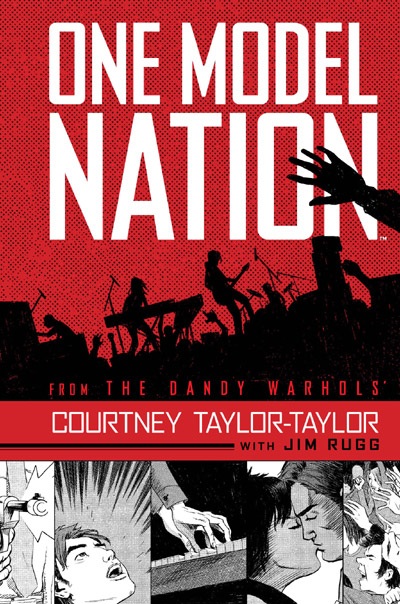
ONE MODEL NATION OGN
Writer: Courtney Taylor-TaylorIllustrator: Jim Rugg
Publisher: Titan Books
Reviewer: superhero
It’s really interesting that, a couple of days before I received this book to review, I had coincidentally watched the movie The Baader-Meinhoff Komplex (as well as checked out www.baader-meinhof.com after the movie) on Netflix a couple of nights before. Otherwise, I think I might have been a bit lost while I read this book. It’s not that you have to have a complete understanding of the social-political climate of West Germany in the nineteen seventies to fully appreciate this book, but I do think that it might be better understood if you had more information about the era in which it takes place. Much like many Americans who were five to ten years old during the time period in which this graphic novel occurs I was woefully ignorant of The Baader-Meinhoff Gang and their terrorist shenanigans until I saw the aforementioned film.
That’s not to say that ONE MODEL NATION is about The Baader-Meinhoff Gang specifically. It’s not. But they (or fictional avatars of them) are present in the book and their “movement” is certainly a big factor in the world that surrounds the events in ONE MODEL NATION. Instead of the comic being directly about socialist “activists” Andread Baader and Ulrike Meinhoff it focuses more on a fictional rock band called, well, ONE MODEL NATION, that, despite their best efforts not to, become swallowed up by the political actions of the Red Army Faction. ONE MODEL NATION focuses primarily on how a group of mostly peace-loving electronic musicians see their band become the voice of a movement that, quite frankly, they have no real desire to be a part of.
Rock star-lead singer of the Dany Warhols Courtney Taylor-Taylor does a very good job with the writing chores here. This is a story that could have easily just devolved into an overly dramatic action piece in the wrong hands. Taylor-Taylor does a great job of keeping things direct and subtle without sacrificing any tension or humanity that arises in the story. There are definitely violent moments of the book; to be sure it was a dangerous time, but what Taylor-Taylor tags perfectly in the comic are the small human moments in between the drama. There is a part in the book where a band member goes to visit his father that I just found perfectly crafted. Sure, there’s a lot to be said about being a rock band during a time of political turmoil but it’s the humanity surrounding it that interested me the most. It’s on that level that Taylor-Taylor succeeds with his story.
Artist Jim Rugg does a great job with the storytelling chores in the book. The panel progression in ONE MODEL NATION is crisp and straightforward and follows Taylor-Taylor’s lead in establishing a direct and interesting narrative. Rugg is able to take the quiet moments and pull power out of them and also make the big, dramatic moments powerful. He’s a skilled storyteller who adapts to the needs of the story. My only small quibble with Rugg’s art was that there didn’t seem to be enough of a variation with facial characteristics when it came to members of the actual band. There were times in ONE MODEL NATION where I got a bit lost in which band member the book was focusing on because they all looked very similar to me. But the musicians in ONE MODEL NATION are supposed to dress and appear alike, so it may be that it’s intended for the reader to focus more on who’s who when the focus shifts between characters.
From the bit of research I’ve pulled together about this book it seems as if this release is a re-issue of an Image Comics printing. Titan Books has done a great job with this edition. It’s a beautifully designed little hardcover chock full of extras including lots of commentary from Taylor-Taylor on how the book came to be and tons of concept art from Rugg as well as other artists who helped flesh out the concept from its beginnings. All in all I’d say that ONE MODEL NATION is worth a look if you haven’t read it already, especially if you’re an indie comics fan. It’s a good story that should appeal to those who like comics that have realistic characters along with a small bit of socio-political history mixed in.
Discovered as a babe in an abandoned comic book storage box and bitten by a radioactive comic fan when he was a teenager, superhero is actually not-so mild mannered sometime designer & cartoonist, Kristian Horn of Los Angeles, California. Some of his work can be seen at www.kristianhorn.com and check out his blog at www.parttimefanboy.com. You can check also out his webcomics at www.babybadass.com and thediplomatics.com, which is currently in development.

X-FACTOR #230
Writer: Peter DavidPenciler: Emanuela Lupacchino
Published by: Marvel Comics
Reviewed by: BottleImp
Peter David’s got a lot of balls.
Wait, that didn’t come out right…
What I should have said was, Peter David’s JUGGLING a lot of balls with his current X-FACTOR storyline(s). Here’s a quick rundown, just in case you weren’t up to speed: Jamie Madrox is apparently dead, killed by the demonic assassin Bloodbath a couple issues ago. At least, that’s what the rest of the X-Factor team thinks. Madrox is in fact bouncing around alternate realities, including one similar to a vision that Rahne Sinclair (aka Wolfsbane) experienced ages ago, when she saw herself standing over the butchered bodies of a newlywed Madrox and Layla Miller. Layla Miller, the girl “who knows things,” has returned from the future grown to adulthood, and has acquired a combination of mystical knowledge and technological weaponry from time spent under the tutelage of Doctor Doom. Layla also has recently brought Guido (aka Strong Guy) back from the dead, but at the cost of leaving the wisecracking giant without a soul—a fact that the rest of the team now knows. Shatterstar, Rictor and Rahne are embroiled in a low-level tension due to convoluted shared sexual history. The team has a troll for a receptionist. Havok and Polaris are coming back to the title. Oh, and Wolverine drops by for a chat. Like I said, a lot of balls in the air here.
What amazes me (and by now really shouldn’t, since David’s been doing it every month for the past year) is that even with all these dangling plot threads, X-FACTOR never feels heavy. Even with an issue such as this one, which is 99.9% people standing around and talking, X-FACTOR never feels boring. And even with a fairly large cast of characters (and two more coming in to the mix), X-FACTOR never feels crowded. David’s pacing, his sense of wit (one of my favorite moments in this issue: Rictor says, ”Someone unexpected showed up at the front door. You’ll never guess who.” Shatterstar: “Wolverine?” Rahne: “How did ye know?” Shatterstar: “Well, he tends to be everywhere.”), his unerring knack for writing characters that read more like real people than two-dimensional collections of line and color—all of it combines together to make the story dance along with a vibrancy and energy that seems harder and harder to find in superhero comics these days. I mean, he’s got characters debating the existential condition of having no soul, for chrissakes, and these pages are livelier than anything you’ll find in the majority of the spandex-clad slugfests!
Credit also must be given to the incredibly talented artists that Peter David has worked with on the series, ‘cause these are the people who take those words and subtle nuances of language and transform them into the motive, dynamic characters that we see on the page. Emanuela Lupacchino, back on the title after an absence of a few months, does top-notch work here. Her faces aren’t the stiff, stolid hunks of granite that you’ll see in some comics, nor are they the obviously over-photo-referenced tracings that pop up here and there. Lupacchino knows facial expressions—the characters grin, grimace, smirk, shout, sneer and weep with real emotion in every carefully-placed line. The women are beautiful without falling into the trap of looking like zombie-like runway models. The men are rugged and handsome without falling into the trap of looking like Abercrombie & Fitch models. The troll is… trollish, I guess. The artwork makes X-FACTOR as much of a treat to look at as it is to read every month, and this rare combination of perfectly complementary words and visuals is what puts the title at the top of my must-read list.
But oh, so many balls. All kept in the air with such assured skill. Peter David, I would doff my cap if I wore one, good sir, for you are truly a Master Ball Handler. And if anyone out there likes to be entertained by a man who knows how to handle a lot of balls at the same time, what are you waiting for? Drop your own balls and put your hands on a copy of X-FACTOR instead.
@@@@ CHEAP SHOTS! @@@@
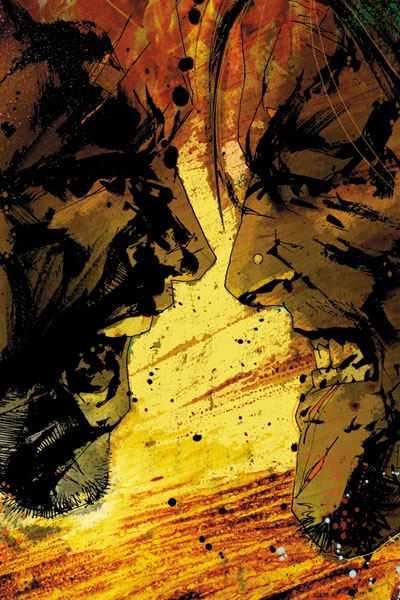 SCALPED #55
SCALPED #55DC Comics
This issue of SCALPED is easily the most ironic book of the year thus far in that it figures it comes out to start 2012 as we @$$holes are working on our “Best of 2011” material. Two weeks earlier and this thing would have kicked down the front door of my list’s house and then proceeded to make sweet, passionate love to its mother all night. At least this will make things easy for me forty-nine weeks from now when it comes list time again. There’s one arc left in this book but this particular issue was pretty much the culmination of five years of blood and tears and tragedy and it was a perfect payoff with plenty more blood added to the tab. The biggest ringing endorsement I think I can give to both this issue and the series as a whole is that, despite the unbelievable high this issue hit and there being only a handful of issues left, I in no way believe we’ll see some sort of “cool down” to the finale or that there isn’t at least one more “oh fuck” or two to come. And when that sad day comes and that book ceases to be, it’s a shoe-in for one more list of mine, and that would be regarding the best comics I’ve ever read. - Humphrey Lee
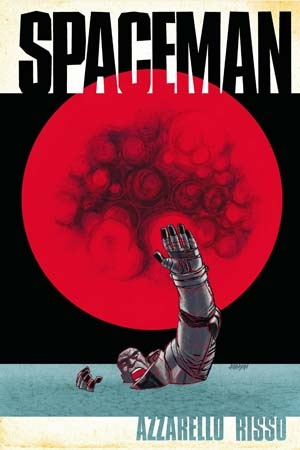 SPACEMAN #3
SPACEMAN #3DC Vertigo
While this particular issue of SPACEMAN I did not really feel moved the book much in the way of plot outside of introducing a couple new characters, I still really like what this book is doing. I love the look aesthetically, of course, since Risso is easily one of the best in the business, but I burnt out on the look and feel the futuristic setting has. The commentary on celebrity, social media and its impact on person-to-person interaction (at least when it comes to speech), and reality entertainment programming it is making is pretty well realized in that it is not overly blatant or exaggerated but is definitely apparent and poignant. And I really dig on the backstory of the Spaceman and why he is as lovable in that “dumb guy who just keeps getting in over his head but really means well” fashion that he is. It would have been hard for me to ever admitting to disliking an Azz and Risso joint and, despite reservations at the start, it looks like I won’t have to given how this story has played out since. - Humphrey Lee
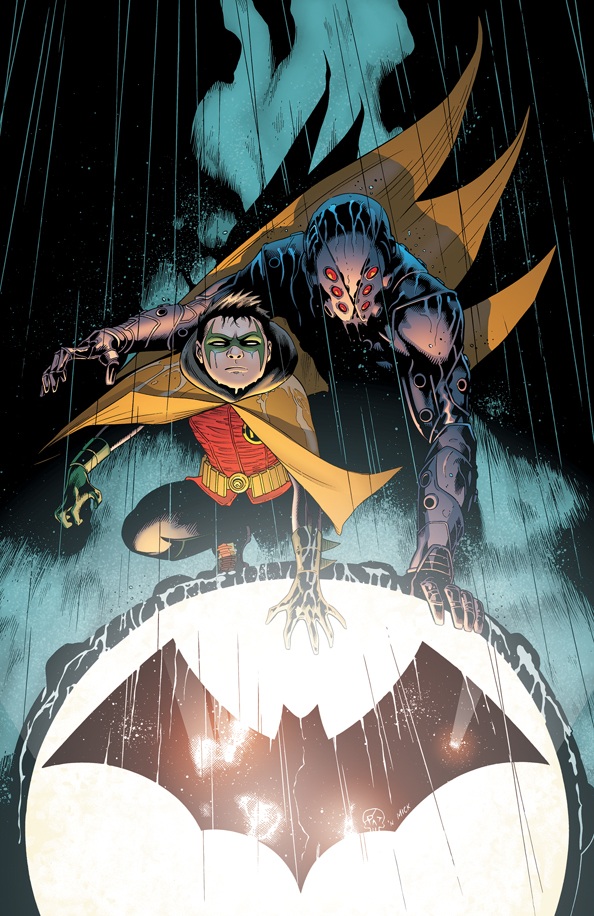 BATMAN & ROBIN #5DC Comics
BATMAN & ROBIN #5DC ComicsIf anything has come out of the New 52 movement, I think it’s fair to say that Batman and Bat-related titles have come out of it all in at least the “pretty-readable” to “downright fantastic” range. BATMAN AND ROBIN, in my opinion, is very much toward the latter end of that spectrum. Tomasi is really doing a great job working the absent father and begrudging child routine between the two, especially in the way he plays up the idea it’s between the world’s most dangerous man and his insanely aggressive son. The focus and backstory on Ducard as a villain is also greatly handled as it adds some depth to the history of a character that gets shockingly overlooked in the wake of “Batman Begins” and has a nice correlation to what is going on with Bruce and Damian. And while the end result of this dalliance between Damian and Ducard could easily end in the typical “it was all a ruse” manner, between Damian’s rage at the criminal element and his father plus his own arrogance, it is selling itself very well in the meantime that maybe, just maybe, he won’t go back. Either way, though, between the why the story is being portrayed from a writing standpoint (and from a gorgeous art standpoint as well) this title has been a bright spot in a segment of the relaunch that already has a couple of them. - Humphrey Lee
@@@@ AICN COMICS PODCAST #13 @@@@

Looks for more of the Holes rambling about comics on Poptards in future AICN COMICS columns!
Proofs, co-edits & common sense provided by Sleazy G
Check out AICN COMICS on Facebook and Comixpedia.org!
